

Flexible Seating and Student-Centered Classroom Redesign. I remember exactly where I was when I had a watershed moment that changed me as a teacher forever.

In fact, it inspired my EdSurge column, Why the 21st-Century Classroom May Remind You of Starbucks. Can students who are constantly on their devices actually learn? I have a rule about cellphones in class: if one disrupts us by ringing, vibrating or sounding an alarm, the owner has to sing a song or bust some dance moves in front of the class.
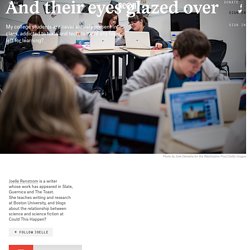
Cultivating a Classroom Culture of Creativity. A Guest Blog Post by Jeanne Muzi Cultivating a Classroom Culture of Creativity is a mindset and a skill set.
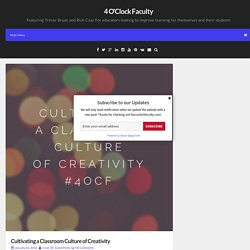
You must believe in the power of incorporating creative problem solving and thinking activities into all the subject areas and be ready to take advantage of the “pockets” of time that develop during “normal” school days…when you have 5 minutes at the end of a lesson, two minutes during a transition, the 10 minutes you gain when an assembly finishes early, etc. By using every opportunity to intentionally cultivate creativity, students can learn, practice and enhance their creative thinking skills!
The Reflective Teacher: Taking a Long Look. School has been in session for a few weeks, and things might be finally settling down for most teachers.

Days seem to pass by so quickly that it seems amazing anything was accomplished. Despite the whirlwind start of the year, it's still important to make time for reflection. Recognizing and Overcoming False Growth Mindset. All educators care deeply about their students' motivation.
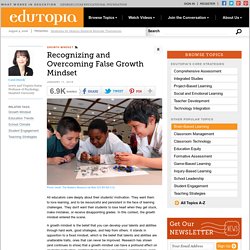
They want them to love learning, and to be resourceful and persistent in the face of learning challenges. They don't want their students to lose heart when they get stuck, make mistakes, or receive disappointing grades. In this context, the growth mindset entered the scene. 22 Powerful Closure Activities. Too many university supervisors and administrators criticize the absence of lesson closure, a dubious assessment practice likely caused by the improper use of Madeline Hunter’s lesson plan model (PDF) as a de facto checklist of eight mandatory teaching practices -- anticipatory set, objective and purpose, input, modeling, checking for understanding, guided practice, independent practice, and closure -- a custom that Hunter decried in 1985 (PDF).

Although it offers multiple benefits, please don't view closure as a professional must-do. What Is Closure? Closure is the activity that ends a lesson and creates a lasting impression, a phenomenon that Colorado State University professor Rod Lucero calls the recency effect. Teachers use closure to: Check for understanding and inform subsequent instructionEmphasize key informationTie up loose endsCorrect misunderstandings. 16 Reasons to Make 2016 the Year of the Read-Aloud.
iTeach and iLearn: No More Crappy Homework. Please forgive me for using "crappy" in the title of this post if that language offends you.
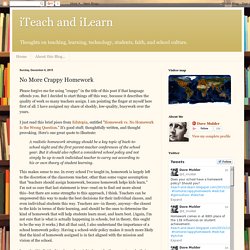
But I decided to start things off this way, because it describes the quality of work so many teachers assign. I am pointing the finger at myself here first of all. I have assigned my share of shoddy, low-quality, busywork over the years. I just read this brief piece from Edutopia, entitled "Homework vs. No Homework Is the Wrong Question. " A realistic homework strategy should be a key topic of back-to-school night and the first parent-teacher conferences of the school year. Improving Instruction: 8 Areas That Matter Most. "Where do we start?
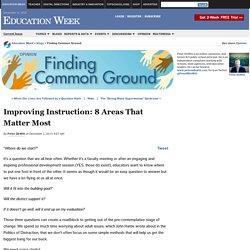
" It's a question that we all hear often. Whether it's a faculty meeting or after an engaging and inspiring professional development session (YES, those do exist!) 10 Websites That Teachers Love Right Now! While visiting classrooms every day, I see teachers utilizing a great deal of technology.
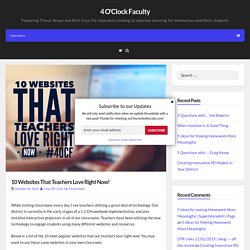
Our district is currently in the early stages of a 1:1 Chromebook implementation, and also installed interactive projectors in all of our classrooms. Teachers have been utilizing the new technology to engage students using many different websites and resources. 5 Reasons to Use Mentor Texts With Big Kids - The Teacher Next Door - Creative Ideas From My Classroom To Yours. When I changed grade levels from second grade to 4th/5th, one of the things I really thought I would miss was all of my wonderful picture books.

I used to love to read and re-read them to the kids, to gaze at their delightful pictures, and to use them to get kids excited about the magic of reading. The 8 Minutes That Matter Most. I am an English teacher, so my ears perk up when writers talk about their process. I've found the advice handy for lesson planning, too. That's because both writing and planning deal with craft. In writing, you want your audience to be absorbed. Great books that inspire a love of reading in kids — recommended by kids. In this Dec. 1, 2014 photo, from left, Edgewood Elementary School kindergartners Asha Wilson, Jacob Grimm and Hunter Potter look over the “Acoustic Rooster and his Barnyard Band,” book in Fruitport, Mich. (AP Photo/Grand Haven Tribune, Krystle Wagner) The only way to hook children on reading for pleasure is to allow them to read for pleasure. That means permitting them to choose the books that interest them and then letting them to read at their own pace, without being asked to analyze every single sentence for inner meaning.
This is the way kids learn to love to read at the Center for Teaching and Learning, an award-winning non-profit independent demonstration school in Maine that was founded in 1990 by educator Nancie Atwell, who last month was awarded the first $1 million Global Teacher Prize given by the Varkey Foundation. By Nancie Atwell The annual average number of books read by seventh and eighth grade readers at CTL is at least forty titles.
What's Really Wrong With Round Robin Reading? By Melanie R. Kuhn Boston University May 7, 2014 I’ve been asked this question about Round Robin Reading many times and in multiple forms. It is usually accompanied by statements such as: “But my students really like it” or “It helps me cover material that is just too hard for them to read” or “I don’t go in any particular order, so they never know when they are going to have their turn.” In fact, these comments come up so often, that Gwynne Ash, Sharon Walpole, and I asked teachers why they chose to use Round Robin Reading or its variants such as Popcorn, Popsicle, or Combat Reading (2009; Ash & Kuhn, 2006).
Our goal was to better understand the perceived pluses of these approaches and identify alternatives that could better meet educators’ instructional goals. 11 Alternatives to "Round Robin" (and "Popcorn") Reading. Round Robin Reading (RRR) has been a classroom staple for over 200 years and an activity that over half of K-8 teachers report using in one of its many forms, such as Popcorn Reading.
RRR's popularity endures, despite overwhelming criticism that the practice is ineffective for its stated purpose: enhancing fluency, word decoding, and comprehension. Cecile Somme echoes that perspective in Popcorn Reading: The Need to Encourage Reflective Practice: "Popcorn reading is one of the sure-fire ways to get kids who are already hesitant about reading to really hate reading.
" Facts About Round Robin Reading In RRR, students read orally from a common text, one child after another, while the rest of the class follows along in their copies of the text. Several spinoffs of the technique offer negligible advantages over RRR, if any. 10 ways YouTube can engage your classes now. YouTube can help teachers and students create powerful, engaging, creative videos.
25 Anchor Charts for Teaching Writing. Teaching With a Mountain View: Anchor Chart Tips & Tricks. Question-Answer Relationship (QAR) 1. 30 Trends In Education Technology For 2015. Via TeachThought. Give Kids Their Reading Choice. Common Core in Action: Using Digital Storytelling Tools in the ELA Classroom. The Importance of Independent Reading in Elementary Schools. Handwriting in the Time of Common Core.
The Top Ten Read Aloud Picture Books in 2014 (so far) How iPads Can Refresh Traditional Classrooms. Following the trend of mass mobile device adoption, educators increasingly contemplate possibilities of using iPads in classroom. 6 Reading Comprehension Problems & What To Do About It. 25 Question Stems Framed Around Bloom's Taxonomy. 25 Question Stems Framed Around Bloom’s Taxonomy While critical thinking is a foundation rather than a brick, how you build that foundation depends on the learning process itself: exposing students to new thinking and promoting interaction with that thinking in a gradual release of responsibility approach.
Flipped Classrooms and Flipped Lessons: What Does It Mean for Parents? Anticipation Guide. Paired (or Partner) Reading. 13 Strategies to Improve Student Classroom Discussions. Log In - The New York Times. What is dyslexia? - Kelli Sandman-Hurley. Vocabulary Development During Read-Alouds: Primary Practices. Homophones: How to Choose Which One. Waiting Rarely Works: Late Bloomers Usually Just Wilt. Booksource's Top Ten Titles to Inspire Creativity and Innovation! Interactive Read Aloud: How To Do It and Why It Works.